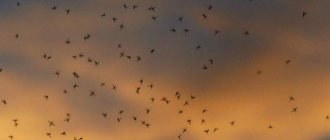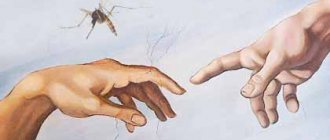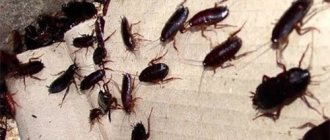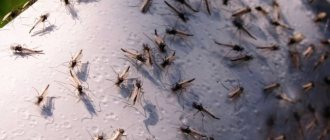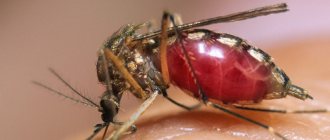You can hide from the ubiquitous mosquitoes only in the zone of eternal ice. The rest of the land is a habitat for dangerous bloodsuckers. The thirst for blood overwhelms exclusively fertilized females. Having drunk blood, they lay eggs in any damp place, preferably in a body of water, and again look for a partner. This cycle is repeated throughout the mosquito’s short life.
True, it seems short-lived only in comparison with other representatives of the fauna. A female mosquito can live 3-12 weeks and during this time is capable of driving the most persistent insect lover into a “white heat” with its bites. In addition to allergies in the form of itching, swelling, pests carry mosquito-borne diseases that are dangerous to humans.
What is the danger of mosquito bites
Only females bite; males get enough nectar. Flying “vampires” carry malaria, fevers: yellow, Zika, Dengue, Chikunya, LNZ, and can cause the terrible disease dirofilariasis.
Let conservationists talk as much as they want about the need for mosquitoes in the ecosystem, with the first warm days it is better to stock up on repellents, buy mosquito repellents, traps or insect killers. Means of protection against bloodsuckers and their exterminators are a must-have baggage for walks outside the city, trips to the country, and hikes.
You should not rely on “maybe” and local medicine when traveling abroad. Excursions to a wild forest or an abandoned temple can give not only pleasant emotions. Such a walk through the jungle can end in the hospital. And it’s good if a populated area is nearby, there will be a clinic there, and it will have experienced staff and the necessary medicines and equipment.
How dangerous are mosquitoes?
Bites from mosquitoes and their close relatives, mosquitoes, pose a danger to human health. Main negative factors:
- an allergic reaction caused by insect saliva entering the human body;
- skin diseases arising from initial skin lesions;
- the likelihood of infection of wounds from bites and, as a consequence, the development of an inflammatory process, an abscess;
- high risk of infection with infectious diseases whose pathogens are carried by insects.
In addition, mosquitoes cause severe psychological discomfort, especially in the warm season. Their annoying flickering before the eyes, disgusting squeaking, constant attempts to sit on open areas of skin irritate, interfere with sound sleep, and turn outdoor recreation into a struggle for survival.
Malaria is the most common mosquito-borne disease
Older people remember that until the second half of the 20th century, malaria was a real problem. In the USSR, they got rid of the disease only in 1960; this required mass treatment of patients and extensive use of insecticides.
Today in the Russian Federation there is no “local” malaria, but there are plenty of imported varieties. And in 2000, cases of malaria were registered in Moscow among people who had never traveled anywhere except the Moscow region. The source of infection may not be very far away; a hungry mosquito will suffice. After a bite, malarial plasmodia develop in the female's stomach. Over the course of several weeks, the plasmodia mature, penetrate the mosquito’s salivary apparatus, and that’s it – the female infects all her “donors” when she bites.
Malaria cannot be underestimated; it causes damage to internal organs, leading to the death of every hundredth patient. Survivors forever remember anemia, high temperature, and fever.
The incubation period of malaria reaches 1.5 months. If you or someone in your family has returned from hot countries with low levels of medical care, such as India, and suddenly develops a high temperature, chills, or fever, call your doctor immediately. When going on vacation to a country where malaria is common, take preventative medications and stock up on repellents. If you contracted the disease in another country, immediately consult a doctor, he will recommend medications for treatment.
Tropical Troubles: A Master List of Mosquito-Borne Diseases
The vast majority of mosquito-borne diseases are of little relevance in temperate climates. Even the names, literally straight from the pages of books, speak for themselves.
Malaria is an extremely dangerous disease. It could have wiped out all of humanity before the invention of treatment, if it had not been transmitted only by malaria mosquitoes, but there are relatively few of them and they feed only where they live.
Yellow fever, West Nile fever, various types of hemorrhagic fevers. Some of them have not yet been treated. In general, all of these tropical mosquito diseases are similar to malaria.
West Nile fever (WNF)
This disease can be found not only in Egypt, but also in the southern regions of the Russian Federation. Disease carriers are mosquitoes, and birds are donors. The incubation period of the disease is 3-21 days, it is caused by an arbovirus. Clinical signs resemble serous meningitis:
- fever;
- headache;
- rash.
Every year, WNV is diagnosed in hundreds of patients in the Astrakhan, Saratov, and Volgograd regions. The mortality rate is 5%, at risk are the elderly, children, patients with poor health, chronic pathologies.
There is no vaccine against WNV. The probability of developing serous meningitis is 1:140.
Diseases that can be found in Russia
On the territory of the Russian Federation there are 3 types of mosquitoes that can be carriers of dangerous diseases:
- real;
- burning;
- malarial.
The stinging mosquito is distinguished by white spots on its legs and dark spots on its wings.
Let's take a closer look at the diseases these insects carry.
- Meningitis is inflammation of the brain and spinal cord. Its symptoms are severe headache, weakness, elevated body temperature, acute sensitivity to light or sound, fever and confusion. Without proper treatment, meningitis can cause very serious complications: hearing and vision impairment, hydrocephalus, paralysis and decreased mental abilities. In 10% of cases there is death. Meningitis can be transmitted by true mosquitoes, which pick up the pathogen from birds.
- Japanese encephalitis, despite its name, occurs not only in Japan, but also throughout almost the entire Pacific region. In Russia, you can become infected in the Primorsky Territory. The disease manifests itself abruptly, with the rapid onset of symptoms. In the first days there is general weakness, drowsiness and fatigue. In the following days, fever, fever, headache, double vision in the eyes, general deterioration of vision and conjunctivitis occur. In the future, the patient may go into a comatose state. Mortality is observed in 40–70% of cases. Japanese encephalitis is also transmitted by true mosquitoes.
- Malaria. The same disease that is spread by the famous malaria mosquitoes. The risk of getting bitten by a malarial mosquito and becoming infected is quite low, but it does exist. Malaria mosquitoes live in the European part of Russia, Western Siberia and the south of the Far East. When infected with malaria, the patient experiences fever, aching joints, convulsions, and high temperature. Possibility of cerebrovascular accident and extremely severe headache. Malaria can be fatal if the patient is not given timely medical care. Children and pregnant women are most at risk.
The main vectors of malaria are malaria mosquitoes.
- Tularemia occurs in almost all latitudes of our country. Every year, 150–250 cases of tularemia are recorded. The main carriers of infection are rodents and blood-sucking insects. Tularemia is characterized by a sharp increase in temperature to 38.5–40 °C. Severe headache, weakness, dizziness, pain in muscles and joints occur. There is a change in consciousness against the background of high temperature. External signs are a gray coating on the tongue and pinpoint hemorrhages throughout the oral cavity. The lymph nodes become greatly enlarged, swelling and redness of the face occurs. There is also a bubonic form of this disease, characterized by the appearance of buboes with pus. A patient with tularemia must be hospitalized, otherwise complications and death are possible. Tularemia is transmitted by stinging and true mosquitoes.
- Mosquito allergy is not an infectious disease, but it is no less dangerous. In addition, allergies are much more common than malaria. A mosquito bite for an allergy sufferer can cause swelling, severe itching, and a rash. Possible reactions from the gastrointestinal tract include nausea, vomiting, abdominal pain and diarrhea. The most dangerous factor is the possibility of suffocation due to swelling of the larynx or anaphylactic shock. If, after being bitten by a mosquito, a person experiences severe swelling of the face, neck and head and has difficulty breathing, they should be taken to the doctor immediately.
An allergic reaction can cause swelling of the throat and choking
Methods of killing mosquitoes
In order not to face the danger of diseases, to protect yourself and your loved ones, you need powerful mosquito repellers. And the conversation is not about repellents or fumigators; EcoSniper mosquito traps or mosquito killers will help here:
- EcoSniper mosquito traps do not emit odors, are non-toxic and can be used in residential areas. A device with a bright lamp attracts bloodsuckers, they fly up, but can’t get out.
- EcoSniper mosquito exterminators have a simple design, but are extremely effective. The environmentally friendly devices are also equipped with a bright lamp, imitate body heat and human breathing, but have a special energized grid. The bloodsuckers fall onto the mesh and burn.
EcoSniper mosquito killers and traps are absolutely safe for people and pets, meet sanitary safety standards and can be used to protect residential, non-residential premises, utility rooms, kitchen areas, etc. To buy high-quality EcoSniper mosquito killers, call our company. A specialist will help you choose a suitable device, taking into account the individual characteristics of the room and the owner’s requirements.
Malaria
Malaria is a dangerous disease that a person becomes infected with when bitten by a mosquito. It is popularly known as swamp disease. There is a risk of its occurrence in tropical and subtropical forests.
The main symptoms are chills and fever, headaches and general intoxication of the body.
Important!
The cause of the disease is malaria mosquitoes that carry the Pfalciparum virus. Having bitten an infected person, the virus multiplies in the female for 10-20 days and is then transmitted to another person during the bite.
This microorganism enters the human liver, where it easily develops and grows, thereby affecting the human organ. After this, it penetrates into the blood, where it affects red blood cells, causing the blood cells to burst. The infection from there enters the plasma. Every two days the process is repeated. Therefore, a person infected with malaria feels a fever.
Pappataci fever
This type of disease is also called phlebotomy. The viral infection is spread by mosquitoes of the Pappataci family. They live in the following areas:
- Balkans;
- Asia (Central and Southeast);
- Mediterranean;
- Near East.
Mosquitoes are especially active in the evening, and they only fly above the ground (up to two meters). It is possible to protect Pappatachi from the bites of bloodsuckers only with the help of special means. After infection, the incubation period lasts no more than 8 days, after which the following symptoms suddenly appear:
- Pain in muscles and joints.
- Chills.
- Fever.
- Eye pain.
- General apathy and weakness.
Treatment is carried out with painkillers and antipyretics.
Mosquito-borne diseases
When a human bites, a female mosquito (and only females bite) introduces certain substances into the victim’s blood that help saturate it more effectively. For example, one of them is a special anticoagulant that prevents blood clotting. Among the substances that enter the human blood in this way, there may well be infectious diseases. Let's consider only the most dangerous of them.
Malaria
Mosquitoes are capable of transmitting the causative agent of malaria, Plasmodium falciparum. Many people know this disease as swamp fever. It is accompanied by the following symptoms:
- the appearance of fever;
- periodic chills;
- headache;
- nausea;
- general weakness and malaise.
Also with malaria, hepatomegaly is observed - liver enlargement, anemia and a number of other dangerous symptoms. This disease is often confused with the common flu, so you need to be very careful in identifying the symptoms and not neglect going to the doctor.
According to existing statistics, about 2 million people die from malaria every year in the world. It is clear that the disease is very dangerous and requires immediate professional medical intervention. Malaria is most widespread in Central Africa and India, but sometimes occurs in Russia. Recently, quite sad statistics have been observed - malaria mosquitoes are found even in those regions where, it would seem, they should have no place at all. This state of affairs is facilitated by many factors, in particular the drainage of swamps and the gradual cessation of reclamation work.
Zika disease
An arboviral infectious disease, which, although its course is quite benign, can cause significant damage to health. For Zika disease:
- a large thick rash appears on the skin;
- there is a fever;
- heat;
- redness of the eyes and other negative symptoms.
It is mosquitoes that are blamed for the spread of the disease - in recent years, about 4 million cases of infection with the virus have been reported worldwide.
The virus is distributed mostly in Oceania, Africa and South America. In Brazil, for example, there is literally a widespread infection with this disease. The main danger of infection occurs in infants. Thanks to it, babies can develop microcephaly. The Zika virus is known to be easily contracted by tourists who have visited these regions of the world. Therefore, you should not think that it is so unrealistic to encounter this problem in Russia.
Lymphatic filariasis
Another dangerous disease that can occur after a simple mosquito bite. The infection is characterized by the entry into the human body of worm eggs - the filaria nematode. Once in the blood, parasites can penetrate through the bloodstream into almost any organ and settle there: in the cornea of the eye, in the skin, and in other places. Accumulating in the lymph nodes, mature parasites are capable of forming blood clots and blocking blood vessels. Due to this, the limbs can swell significantly. If treatment is not started in time, lymphatic filariasis can lead to disability and sometimes even death.
Like previous diseases that can arise from mosquito bites, this disease is most common in South America, Africa and hot Asian countries. Since quite powerful tourist trips have been established in these regions, the spread of infection to other, colder countries is quite possible.
Tularemia
This is a focal disease, which also occurs with severe fever, intoxication of the whole body, and damage to the lymph nodes. The carriers of the infection are hares, field mice, rats, and the carriers are mosquitoes, ticks, horseflies and other animals that feed on blood.
Initially, tularemia was common in warm countries and was not common in our area. But a sharp change in climate, a shift in different seasons, long periods of warming and high water, and heavy rainfall influenced the fact that the infection began to appear more and more often in Russia and nearby countries.
Yellow fever
Another one on the list of dangerous infectious diseases that can be caused by a mosquito pathogen. The disease is quite acute, characterized by elevated temperature, damage to the normal functioning of the liver and kidneys. A particularly dangerous symptom of yellow fever, which is also called amaryllosis, is the appearance of internal bleeding in the gastrointestinal tract. The vaccine against the disease has been developed for quite some time and is available to almost every resident of our country. However, the possible dangers of yellow fever should not be underestimated, since even with the means to combat it, about 200,000 people are infected annually in the world. Of these, approximately 30,000 patients die, so the disease is not as harmless as it might seem.
ONN virus
In Africa, mosquito-borne diseases were discovered in several million people in the mid-20th century. The cause of the poor health of the majority of the population was the O'nyong-nyong virus. It is still carried by blood-sucking insects, so residents of the hot mainland actively protect themselves with special means during the epidemiological season. If we talk about what diseases mosquitoes carry in Russia, the infection described is not included in their list. There is no prophylactic injection for the ONN virus yet.
The symptoms of the disease are as follows:
- Strong headache;
- temperature increase up to +40 degrees;
- aching joints;
- inflammation of the lymph nodes;
- rash on the body.
Vivid symptoms disappear after about a few weeks, but joint pain bothers the patient for a long time. A blood test can detect the disease. There are no serious consequences after recovery, but pregnant women rarely manage to save the fetus.
